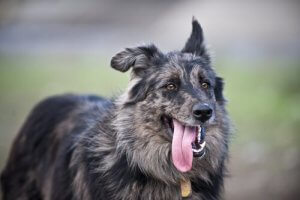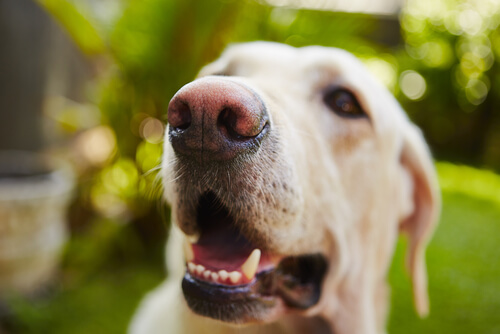How Do Dogs Keep Cool in Summer?


Written and verified by the lawyer Francisco María García
Dogs have glands all over their bodies but, unlike humans, they only produce sweat on areas not covered with fur, such as the pads of their feet. They also use their mouths to help keep them cool – panting is just one of the many methods dogs use to lower their body temperatures. In this article, we’ll tell you how dogs sweat and keep cool in summer.
Dogs sweat through their paw pads

Dogs have small sweat glands on the pads of their feet. These glands help them keep cool in warm weather. There’s also a layer of fat that helps to insulate the inner foot tissues from extreme temperatures, preventing them from getting too hot.
Our four-legged friends also have a natural cooling system in their paws. The veins dilate (expand) and contract to help regulate temperature. As long as the ambient temperature isn’t too high, it can help to lower their body temperature.
Dogs can also use their ears to regulate their temperature. Just like in their paws, the veins in their ears can constrict or dilate as needed.
As you can see, dogs don’t sweat in the same way that humans do. However, they also have other ways to keep themselves cool and regulate their body temperature.
How dogs keep cool: temperature and hydration
While dogs may have very different cooling methods to humans, you still have to remember to keep them well-hydrated. In doing so, you will avoid serious health issues and help improve their mood.
Dogs’ bodies work almost like refrigerators. Their normal temperature fluctuates between 100°F and 102°F. The body detects when it gets too hot and pumps warm blood to the tongue, which has very efficient salivary glands. By panting, the saliva on the tongue evaporates, cooling the blood and helping to reduce body temperature.
By sticking out their tongues and panting, they cool their mouths. The hot vapor expelled by the lungs condenses into a liquid as it hits the cold saliva in their mouths, dripping from the tongue in droplets.
The size of the dog
Large dogs are less effective at cooling than small dogs. One reason for this is that they usually sweat less. Plus, their large size means they generate more heat than they lose.
However, small dogs are less tolerant of natural heat. High temperatures are very dangerous for them, and they are extremely susceptible to heatstroke.
Heatstroke in dogs
If a dog’s internal temperature reaches over 107°F, it’s at serious risk of heatstroke. Heatstroke can be very dangerous for your pet’s health. The seriousness of the consequences will depend on how high the dog’s internal temperature is, and how long it remains at this temperature.
Heatstroke often occurs when a dog is in a car for a long period of time. To prevent it, make sure to turn on the air conditioning and open the windows. You can also cool your dog with ice packs to help lower its body temperature.
Under no circumstances should you leave your dog alone in the car. In just a few minutes, a car can reach incredibly high temperatures, even if it’s parked in the shade with the windows cracked open. Without even realizing it, you might have put your dog in serious danger.
Symptoms of heatstroke
Dogs suffering from heatstroke will have symptoms such as excessive panting, tachycardia, high temperature, congested mucous membrane, vomiting, diarrhea, and, in severe cases, they may go into shock or lose consciousness.
If you notice these symptoms, you must seek veterinary attention as soon as possible. The first thing you should do is move your dog to a cool, well-ventilated space, bathe it with cold water and, if it’s conscious, give it small quantities of fresh water to drink.
How dogs keep cool: the cooling process

Many years ago, scientists discovered that a dog’s internal thermostat – its thermoregulatory system – pumps warm blood to the tongue. The salivary glands open, and they start taking deep, rapid breaths.
As the hot air flows through the trachea and past the tongue, the saliva evaporates from the tongue, cooling the blood. This process lowers the dog’s body temperature and helps to cool the brain.
Dogs have glands all over their bodies but, unlike humans, they only produce sweat on areas not covered with fur, such as the pads of their feet. They also use their mouths to help keep them cool – panting is just one of the many methods dogs use to lower their body temperatures. In this article, we’ll tell you how dogs sweat and keep cool in summer.
Dogs sweat through their paw pads

Dogs have small sweat glands on the pads of their feet. These glands help them keep cool in warm weather. There’s also a layer of fat that helps to insulate the inner foot tissues from extreme temperatures, preventing them from getting too hot.
Our four-legged friends also have a natural cooling system in their paws. The veins dilate (expand) and contract to help regulate temperature. As long as the ambient temperature isn’t too high, it can help to lower their body temperature.
Dogs can also use their ears to regulate their temperature. Just like in their paws, the veins in their ears can constrict or dilate as needed.
As you can see, dogs don’t sweat in the same way that humans do. However, they also have other ways to keep themselves cool and regulate their body temperature.
How dogs keep cool: temperature and hydration
While dogs may have very different cooling methods to humans, you still have to remember to keep them well-hydrated. In doing so, you will avoid serious health issues and help improve their mood.
Dogs’ bodies work almost like refrigerators. Their normal temperature fluctuates between 100°F and 102°F. The body detects when it gets too hot and pumps warm blood to the tongue, which has very efficient salivary glands. By panting, the saliva on the tongue evaporates, cooling the blood and helping to reduce body temperature.
By sticking out their tongues and panting, they cool their mouths. The hot vapor expelled by the lungs condenses into a liquid as it hits the cold saliva in their mouths, dripping from the tongue in droplets.
The size of the dog
Large dogs are less effective at cooling than small dogs. One reason for this is that they usually sweat less. Plus, their large size means they generate more heat than they lose.
However, small dogs are less tolerant of natural heat. High temperatures are very dangerous for them, and they are extremely susceptible to heatstroke.
Heatstroke in dogs
If a dog’s internal temperature reaches over 107°F, it’s at serious risk of heatstroke. Heatstroke can be very dangerous for your pet’s health. The seriousness of the consequences will depend on how high the dog’s internal temperature is, and how long it remains at this temperature.
Heatstroke often occurs when a dog is in a car for a long period of time. To prevent it, make sure to turn on the air conditioning and open the windows. You can also cool your dog with ice packs to help lower its body temperature.
Under no circumstances should you leave your dog alone in the car. In just a few minutes, a car can reach incredibly high temperatures, even if it’s parked in the shade with the windows cracked open. Without even realizing it, you might have put your dog in serious danger.
Symptoms of heatstroke
Dogs suffering from heatstroke will have symptoms such as excessive panting, tachycardia, high temperature, congested mucous membrane, vomiting, diarrhea, and, in severe cases, they may go into shock or lose consciousness.
If you notice these symptoms, you must seek veterinary attention as soon as possible. The first thing you should do is move your dog to a cool, well-ventilated space, bathe it with cold water and, if it’s conscious, give it small quantities of fresh water to drink.
How dogs keep cool: the cooling process

Many years ago, scientists discovered that a dog’s internal thermostat – its thermoregulatory system – pumps warm blood to the tongue. The salivary glands open, and they start taking deep, rapid breaths.
As the hot air flows through the trachea and past the tongue, the saliva evaporates from the tongue, cooling the blood. This process lowers the dog’s body temperature and helps to cool the brain.
This text is provided for informational purposes only and does not replace consultation with a professional. If in doubt, consult your specialist.








